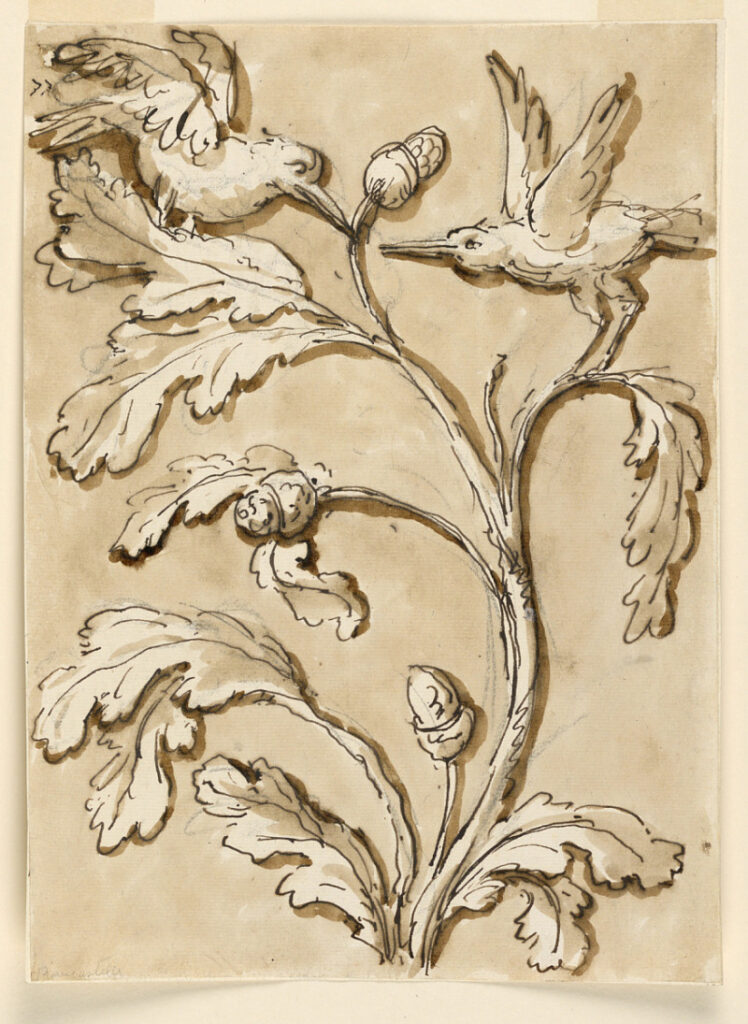What the Birds Said
By Anna Boynton Averill
Annotations by Will Smith/JB

and brown wash, graphite on off-white laid paper, lined, c. 1780 to 1800,
Cooper Hewitt, Smithsonian Design Museum, New York, NY.
In the elm-shaded street,
Broad and dewy and cool,
Loitered two little feet,
On their way to school.
Two little wondering eyes
Watched the swift wings fly
Into the free blue skies
From the elm-tops high.
“Heigh-ho! the fields are fair,
And the woods, and the swirling brooks,
And the birds, are free in the air,” he said;
“What do I care for books?”
And a dozen saucy birds
Sang loud his mood to share,
Loud, bold, and clear, the words,
“Tu-whit! what do we care?”
Then came another day,
Fair and sunny and sweet,
And over the shaded way
There came the little feet.
But O, ‘t was a rueful face,
With eyes and cheeks aflame,
Where tears had left their trace,
And penitence, and shame.
“Your wings should all be clipped,
For the wicked things you say!
I have been soundly whipped,” he said,
“Because I ran away.”
And all the saucy birds
Sang loud his ire to dare, —
Sang bold and clear the words,
“Tu-whit! what do we care?”
Averill, Anna Boynton. “What the Birds Said.” OUR YOUNG FOLKS: AN ILLUSTRATED MAGAZINE FOR BOYS AND GIRLS 9, No. 7 (July 1873): 403.
Contexts
This poem demonstrates that children avoiding school is not a new phenomenon. It is also an interesting take on other poems that use birds as symbols of freedom, such as “Bluebirds in Autumn.” While these other poems may end on an optimistic note, this one presents the harsh reality that more Romantic depictions of birds often avoided. This poem also presents an interesting conversation between the birds and their watchers; however, this conversation, much like the child’s punishment, is far from idealistic. During Reconstruction, when this poem was written, student populations were increasing across the South, especially among formerly enslaved people who were now free to pursue education. Schools throughout the South remained segregated, with government funding largely supporting schools for white students.
Definitions from Oxford English Dictionary:
saucy: Of persons, their dispositions, actions, or language: Insolent towards superiors; presumptuous. Now chiefly colloquial with milder sense, applied to children and servants: Impertinent, rude, “cheeky.”
Resources for Further Study
- The Quest for Education from the Smithsonian National Museum of American History’s Brown vs. Board of Education overview.
- Several historians answer questions about schools in the Reconstruction Era.
- An interview with Christopher Span, a professor of educational policy studies.
- Two historical schoolhouse images with an accompanying essay.
Contemporary Connections
This poem contains some depiction of the typical Romantic notion of nature as an inspiration. As when Averill wrote this poem, humans today can use nature to escape everyday life stress. During the COVID-19 pandemic, nature has become a critical way to feel connected to the world. However, we should remember that, while escaping into nature, the rest of the world does not cease to exist.
The educational system in the U.S. is still grappling with inequality problems, and there is an abundance of scholarship about this ongoing public issue. “Still Separate, Still Unequal: Teaching about School Segregation and Educational Inequality” is an extensive set of resources for educators; “Good School, Rich School; Bad School, Poor School” looks at Connecticut as a microcosm of the role funding plays; and books such as Savannah Shange’s Progressive Dystopia: Abolition, Antiblackness and Schooling in San Francisco and Sarah Ahmed’s On Being Included: Racism and Diversity in Institutional Life look at some of the many facets of a complex and evolving national concern.